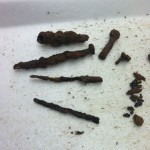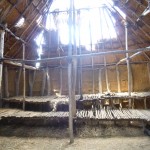Dr. Deanna Grimstead, Associate Professor in the Department of Anthropology of The Ohio State University, and her students are currently working with an Ohio Historical Society Collection from the Proctorville Village Site (Ohio Archaeological Inventory number 33LE12, collection A4197). The collection stems from a 1989 salvage excavation at the location of a large Fort Ancient Village located in Lawrence County. The goals of this project are 1) to use the collection for an introductory undergraduate and graduate level archaeological laboratory methods course, 2) to conduct a thorough zooarchaeological analysis of the archaeofaunal materials from the site, and 3) to further many more collaborative projects between the Ohio Historical Society and The Ohio State University. As part of the course students are giving the opportunity to blog about what they are learning and discovering. The following is the final submission from Lauryn Platt. We hope you enjoyed the student’s journeys as much as we did!
Ciao Ohio Historical Society Archaeology Blog Readers!
I was going through the master catalogue from the original excavation looking for interesting artifacts. When I came across a bag labeled part of a gorget. Needless to say I was very excited, previously someone in my class had found a tooth worked into a bead but a gorget would be more exciting! A gorget is an article of clothing, almost like a modern day choker necklace, that covers the throat area. However, when I found the bag it did not look like a gorget but I could be wrong! Gorgets are typically made of banded slate and are relatively flat. An important thing to keep in mind was that this dig was a salvage dig (before Proctorville could expand their library) and that volunteers worked on this site as well so it could also be a misidentification done in the past as well.
One of the things that I kept coming across was historic metal, historic nails and once the catalogue even said historic square nails (Figure 1). Originally, I wanted to find out what they were used for and what they were made out of. Since the Fort Ancient people lived around 900-1600 A.D., I was also interested in finding information on whether or not the European settlers would have introduced the use of nails, made out of metal or wood. However, when I was looking for sources, papers and articles I couldnt find anything on nails. After searching Google scholar, Ohio States library, Google (at one point I even tried ask.com and other websites such as wiki answers) I realized that there has probably been no studies done on nails. While I concluded that the Fort Ancient people didn’t need nails for building (as I will explain in a little bit), OHS has confirmed that nails were in fact European introduced. The presence of nails suggests that there may have been an old building on the site that was being excavated. So basically the European settlers came over with their building techniques, built buildings and therefore introduced nails.
Before OHS  guided me to the right answer, I came to my own conclusions. SunWatch Village is a known Fort Ancient site in Dayton, Ohio which has a few houses that have been recreated based on the archaeological evidence found on the site (Figure 2). I visited this past summer and have looked at the pictures that I have taken but I have not seen anything being held together with nails (assuming the dwellings were rebuilt correctly) and to be honest it wouldn’t make sense. If, like at SunWatch, these Fort Ancient people in Proctorville were using a mud type material for the outer walls and logs as the inside support structure, nails would not have been the go to building material. Mud type walls do not need nails. The wooden poles, vertically, holding the roof up could have been dug into the ground far enough to where they could stand up alone and then have been tied together with a strong fiber/rope material with the wooden poles supporting the roof horizontally. Therefore, nails were introduced by Europeans and if Proctorville was like SunWatch there was no use for nails.
guided me to the right answer, I came to my own conclusions. SunWatch Village is a known Fort Ancient site in Dayton, Ohio which has a few houses that have been recreated based on the archaeological evidence found on the site (Figure 2). I visited this past summer and have looked at the pictures that I have taken but I have not seen anything being held together with nails (assuming the dwellings were rebuilt correctly) and to be honest it wouldn’t make sense. If, like at SunWatch, these Fort Ancient people in Proctorville were using a mud type material for the outer walls and logs as the inside support structure, nails would not have been the go to building material. Mud type walls do not need nails. The wooden poles, vertically, holding the roof up could have been dug into the ground far enough to where they could stand up alone and then have been tied together with a strong fiber/rope material with the wooden poles supporting the roof horizontally. Therefore, nails were introduced by Europeans and if Proctorville was like SunWatch there was no use for nails.
This will be my last blog and I am very sad that I wont be working with the Proctorville assemblage or writing these blogs anymore :(. I hope all of the readers out there have enjoyed these posts as much as I have enjoyed writing them. I think this post is the perfect ending because it shows that a majority of the past is unknown and can only be speculated on by anthropologists and anthropology students. Will we ever know the answers to our questions? Maybe, but that is the beauty of anthropology! We search for the answers in hopes that it will shed light on where we as humans came from and where we are going.
-Lauryn Platt